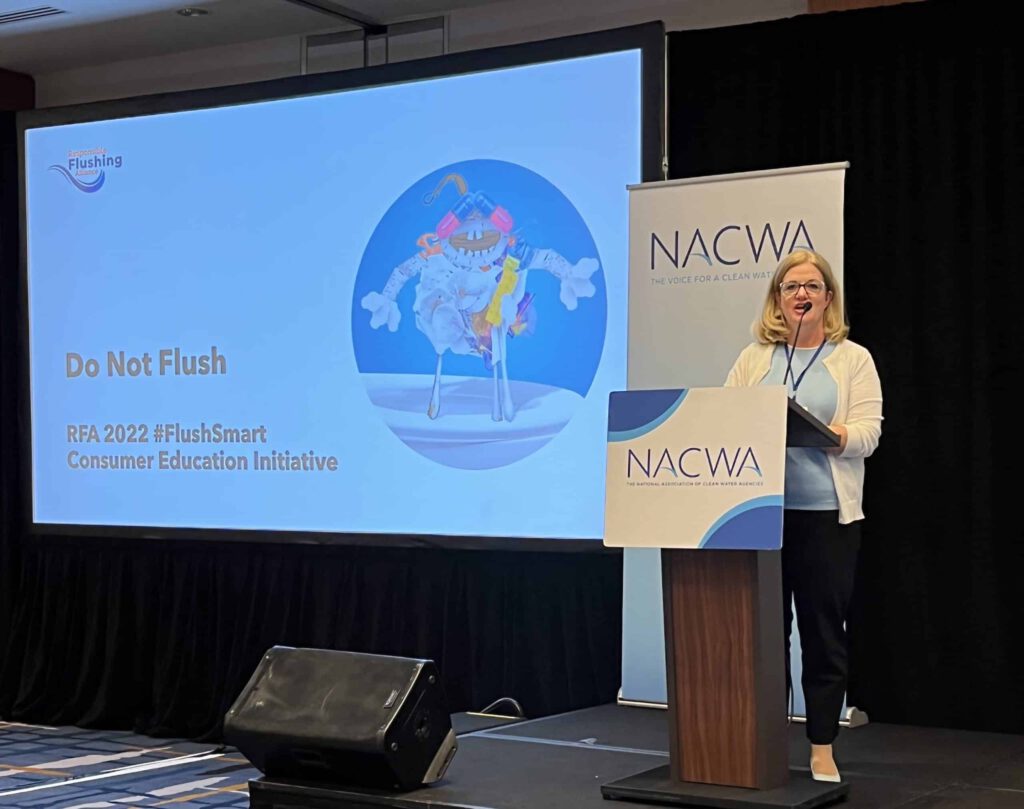Overview
So far this year, the Responsible Flushing Alliance and its supporting members are making a real difference in educating consumers about responsible flushing habits. The #FlushSmart campaign continues running strong on social, in the media, and through our owned channels in hopes of influencing positive impact on home health, community wellbeing, and environmental protection. Congratulations to RFA members; we’re getting noticed!
Due to our voice amplifying in this space, I was invited to attend the NACWA’s (National Association of Clean Water Agencies) 2022 National Pretreatment Workshop, where I gave 180 attendees an update on the progress of the Responsible Flushing Alliance’s #FlushSmart campaign.
Joining me on the “Flushing Awesome: Wipe Labelling and Flushability Progress” panel was Frank Dick, co-chair of NACWA’s Pretreatment and Pollution Prevention Committee and Cynthia Finley, Director of Regulatory Affairs for NACWA.
The session started with an overview of RFA’s #FlushSmart campaign, including an introductory video about RFA, followed by background information of our charter: to provide consumer education around the Do Not Flush symbol on disposable wipes packaging, as well as general information for what should and should not be flushed.
I highlighted the consumer survey we did last November to gauge the knowledge and behaviors of Californians around healthy and proper flushing. Some interesting findings from the survey include:
- Nearly 60% of respondents say they have disposed of something non-flushable in the toilet during the past year. (Boo!)
- But 60% of consumers say they do check packaging for see if the product is flushable. (Yay!)
- 69% of consumers say they recall seeing the “Do Not Flush” symbol but when we asked them where, we got a variety of answers from airplane bathrooms to restaurants or to somewhere in Europe. And
- Men aged 45 and under as well as parents with children in the house were found to be the most prevalent offenders of practicing unsafe flushing habits.
I also showed a video of some consumer participants in San Clemente, California who took our “Test Your #FlushSmart Challenge” quiz.
So why does it matter? NACWA estimates that in 2019 alone the state of California spent $47 million in unplanned expenses to clean up spills and repair wastewater equipment damaged by non-flushable, disposable wipes being flushed.
Based on the disconnect consumers have about what should and should not be flushed, as well as lack of awareness of where to find the “Do Not Flush” symbol (spoiler alert: on the front of non-flushable wipes, including baby wipes, cleaning wipes, and makeup wipes), we see an opportunity for the #FlushSmart campaign to bring greater awareness to consumers and influence a positive behavioral change
The audience of wastewater professionals were very engaged around the resources created by RFA. My presentation highlighted our infographics and educational materials, including our children’s story, “Dogs Against Clogs,” featuring my dog Apollo as the story’s safe flushing hero.
I concluded the session highlighting some of our achievements accomplished to date, including over 600 media stories as well as our growth in social media, both paid and organic, featuring the Clog Monster – the villainous embodiment of items found in sewer clogs. All presentations from the panel are available on the NACWA event website.
This was a wonderful opportunity for wastewater and industry to show progress by partnering to focus on positive solutions to these series issues. I want to provide my thanks to NACWA for the invitation to speak at the conference and to all of the attendees for their great questions and positive feedback.
Lara M. Wyss
President
